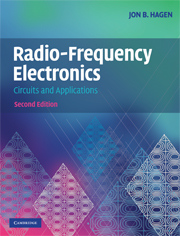Book contents
- Frontmatter
- Contents
- Preface
- 1 Introduction
- 2 Impedance matching
- 3 Linear power amplifiers
- 4 Basic filters
- 5 Frequency converters
- 6 Amplitude and frequency modulation
- 7 Radio receivers
- 8 Suppressed-carrier AM and quadrature AM (QAM)
- 9 Class-C, D, and E Power RF amplifiers
- 10 Transmission lines
- 11 Oscillators
- 12 Phase lock loops and synthesizers
- 13 Coupled-resonator bandpass filters
- 14 Transformers and baluns
- 15 Hybrid couplers
- 16 Waveguide circuits
- 17 Small-signal RF amplifiers
- 18 Demodulators and detectors
- 19 Television systems
- 20 Antennas and radio wave propagation
- 21 Radar
- 22 Digital modulation techniques
- 23 Modulation, noise, and information
- 24 Amplifier and oscillator noise analysis
- 25 The GPS Navigation system
- 26 Radio and radar astronomy
- 27 Radio spectrometry
- 28 S-parameter circuit analysis
- 29 Power supplies
- 30 RF test equipment
- Index
- References
9 - Class-C, D, and E Power RF amplifiers
Published online by Cambridge University Press: 05 June 2012
- Frontmatter
- Contents
- Preface
- 1 Introduction
- 2 Impedance matching
- 3 Linear power amplifiers
- 4 Basic filters
- 5 Frequency converters
- 6 Amplitude and frequency modulation
- 7 Radio receivers
- 8 Suppressed-carrier AM and quadrature AM (QAM)
- 9 Class-C, D, and E Power RF amplifiers
- 10 Transmission lines
- 11 Oscillators
- 12 Phase lock loops and synthesizers
- 13 Coupled-resonator bandpass filters
- 14 Transformers and baluns
- 15 Hybrid couplers
- 16 Waveguide circuits
- 17 Small-signal RF amplifiers
- 18 Demodulators and detectors
- 19 Television systems
- 20 Antennas and radio wave propagation
- 21 Radar
- 22 Digital modulation techniques
- 23 Modulation, noise, and information
- 24 Amplifier and oscillator noise analysis
- 25 The GPS Navigation system
- 26 Radio and radar astronomy
- 27 Radio spectrometry
- 28 S-parameter circuit analysis
- 29 Power supplies
- 30 RF test equipment
- Index
- References
Summary
Class-C, D, and E RF power amplifiers are all about high efficiency. They are used in large transmitters and industrial induction heaters, where high efficiency reduces the power bill and saves on cooling equipment, and also in the smallest transmitters, such as cell phones, where high efficiency increases battery life. These amplifiers are so nonlinear (the output signal amplitude is not proportional to the input signal amplitude), they might better be called synchronized sine wave generators. They consist of a power supply, at least one switching element (a transistor or vacuum tube), and an LCR circuit. The “R” is the load, RL, often the radiation resistance of an antenna, equivalent to a resistor. The LC network is resonant at the operating frequency. The output sine-wave amplitude, while not a linear function of the input signal amplitude, is proportional to the power supply voltage. Thus, these amplifiers can be amplitude modulated by varying the supply voltage. Of course they can also be frequency modulated by varying the drive frequency (within a restricted bandwidth, determined by the Q of the LC circuit). Finally, they can be used as frequency multipliers by driving them at a subharmonic of the operating frequency.
The class-C amplifier
Figure 9.1 shows a class-C amplifier (a), together with an equivalent circuit (b). The circuit looks no different from the class-B amplifier ofFigure 3.15 or a small-signal class-A amplifier.
- Type
- Chapter
- Information
- Radio-Frequency ElectronicsCircuits and Applications, pp. 87 - 100Publisher: Cambridge University PressPrint publication year: 2009



